
Entering the European market for sun and beach travel products
There is a large, competitive market for sun and beach tourism in Europe, particularly in the UK, France and Germany. Fully Independent Travelers (FITs) are the main market for sun and beach travel products in developing countries. A wide range of accommodation types and activities are on the market, including water sports, immersive experiences and community-based tourism (CBT). There are plenty of opportunities for sustainable, responsible businesses to introduce their products onto the market.
Contents of this page
- What requirements and certifications must sun and beach travel products meet to be allowed on the European market?
- Through what channels can you get sun and beach travel products on the European market?
- What competition will you face in the sun and beach market?
- What are the prices for sun and beach products on the European market?
1. What requirements and certifications must sun and beach travel products meet to be allowed on the European market?
Strict regulations require European tour operators that sell sun and beach products to ensure their travellers’ safety and protect them financially. You should understand these regulations.
What are the mandatory and additional requirements that buyers have?
The requirements for agritourism services are common across the sector. They include:
- The European Package Travel Directive
- General Data Protection Regulation (GDPR)
- Liability Insurance and Insolvency Protection
You can find out about them in the CBI’s What requirements must tourism services comply with to be allowed on the European market. This study will help you understand the requirements European tour operators have to comply with. If you understand the requirements they are bound by and can adapt your business to meet their needs, they will be more likely to do business with you. It is important to European buyers that they can trust their suppliers to meet their and their customers’ needs.
What are the requirements for niche markets?
Sustainability is a key requirement for sun and beach tourism. European tour operators have to embed sustainability into their businesses, and they will expect their suppliers to do the same. Having high-quality service standards is another requirement. You should provide a wide range of activities people enjoy at sun and beach destinations. If you provide accommodation, understanding European travellers’ needs is important.
Sustainability is crucial for coastal destinations
Coastal and marine tourism is a major economic sector for destinations with accessible and attractive coastlines. It is often called ‘blue tourism’ and is considered part of the Blue Economy. Many blue tourism activities harm the environment and local communities. As tourism is highly dependent upon the quality of natural resources, it has become even more important that all tourism activities are sustainable.
This infographic shows how healthy oceans are crucial to attract tourists and sustain local economies.
Figure 1: Mapping Ocean Wealth of Tourism
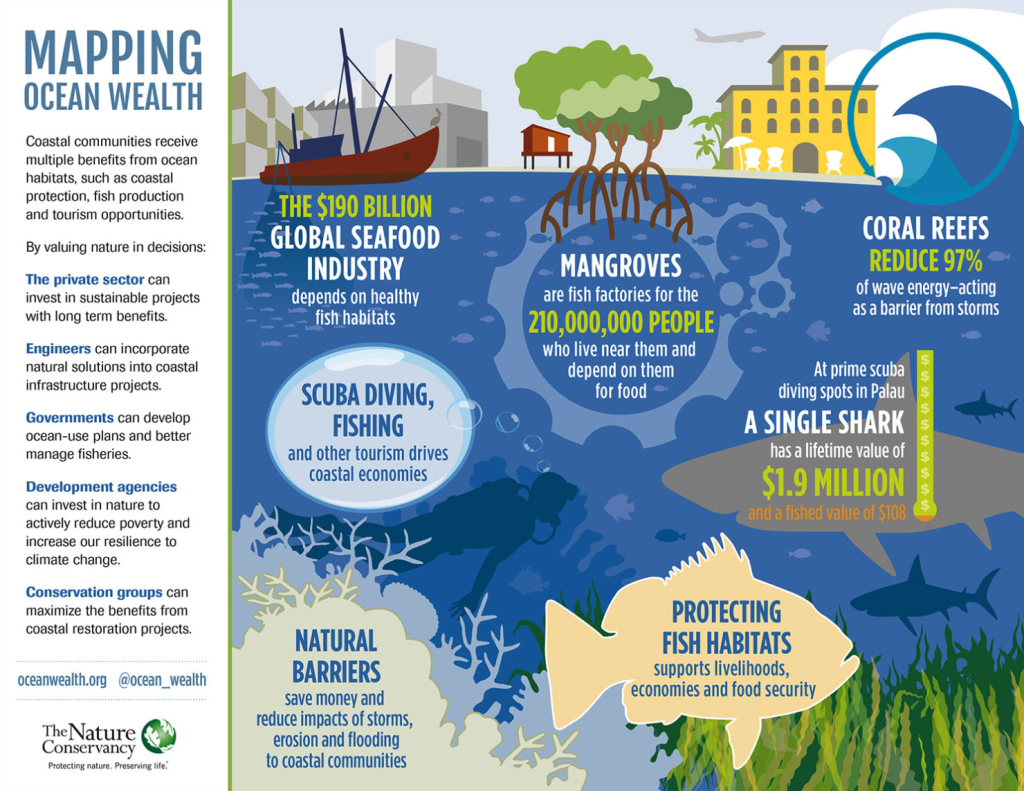
Source: The Nature Conservancy, 2024
European travellers are concerned about sustainability and are increasingly likely to choose destinations that actively promote their sustainable and responsible credentials. They are well informed about the issues that affect beach destinations, including oceans polluted with mountains of waste and marine life that gets tangled in discarded fishing nets or mistakes plastic particles for food.
As a sun and beach tourism provider, sustainability must be at the heart of your business to attract the European market.
Becoming sustainably certified is one of the best things you can do as it tells your buyers that you understand the need to be a sustainable business and are committed to acting sustainably. Travelife for Tour Operators, Good Travel Seal and TourCert are famous European schemes and can be affordable. Alternatively, check if your destination has a sustainability scheme you can sign up for. These schemes include Sustainable Destination (Nordic countries), Slovenia Green, Singapore’s Tourism Sustainability Programme and Responsible Tourism Tanzania.
Becoming sustainably certified takes time and money. If you cannot afford certification right now, ensure you know the criteria and put as many in place as you can. This means you will be able to talk about your actions on your website with confidence. Your buyers will want to know what sustainable actions you take, regardless of whether you are certified or not. Do not overstate your actions. This is known as ‘greenwashing’, and it will harm your reputation if you are found out.
Figure 2: Clear signs will help your guests understand how they should act while on location
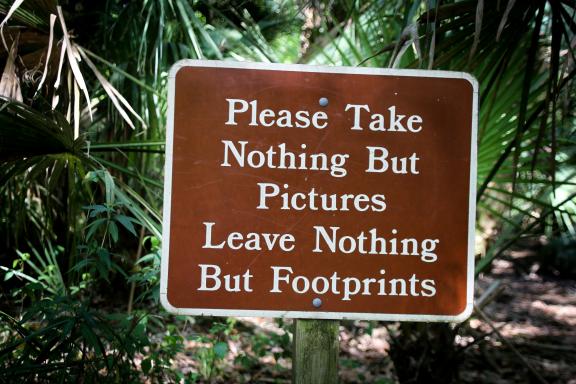
Source: Florida-Guidebook.com at Unsplash, 2021
Several sustainable actions you can consider for your sun and beach business are given below.
- Use sustainable energy sources, such as solar and wind power. Rely on natural light and ventilation where possible.
- Use eco-friendly products throughout your operations, such as non-toxic cleaning and laundry products.
- Implement suitable waste separation disposal practices. You may be able to generate income from recycling or making handmade gifts from waste. Make sure you tell your visitors how to dispose of their rubbish. Provide adequate waste bins that allow for separation. If your location does not have a suitable waste management system, provide visitors with bags for their rubbish.
- Source food and other consumables locally wherever possible. This could include growing your fruit and vegetables and buying produce from local sources.
- Employ local people where possible and pay them a fair wage. Encouraging your visitors to engage in community-based tourism, such as visiting markets, festivals and local villages, is a sustainable form of tourism that benefits local communities.
- Encourage guests to join in with regular beach clean-ups.
- Write a responsible visitor code and promote it on your website to encourage visitors to look after your environment and engage with local communities. See this example from Turtle Bay Resort in Kenya: How to be a responsible tourist. Ensure that partners you work with adhere to your code.
- If your business is located near a coral reef, encourage your visitors to use sunscreens free from chemicals that harm the reef. Make sure you sell these sunscreens, and provide a link to a company that sells them on your website so your guests can buy suitable products before they travel, such as Green People.
Business Insight
Jo Hendrickx, Founder, Travel without Plastic

Plastic pollution often affects beaches and coastal destinations, harming guests’ experiences. Accommodation providers who rely on these environments must help to solve this problem. Starting your plastic reduction journey can be overwhelming, especially if you use many individual products.
There are several ways to start.
- Use purchasing records or receipts to determine which items contribute the most to plastic waste and then eliminate or reduce the top three.
- Identify which items are used out of habit rather than necessity. Remove them completely. If you are concerned about the impact on the guest experience, involve guests and explain why you want to make the changes. You might be surprised by how willing they are to support you.
- Prioritise new processes over new products. For example, remove the minibar and offer room service instead.
- If you have to, replace single-use plastic and try to find reusable alternatives. If reusable alternatives are unavailable, buy products made from materials that your local waste infrastructure can process.
Tips:
- Read about what Sustainable Travel International does to support communities and organisations to develop sustainable tourism practices in terms of oceans, reefs, waste and water.
- Read this study: Blue Tourism – The Transition Towards Sustainable Coastal and Maritime Tourism in World Marine Regions. It outlines the challenges and impacts of tourism on the coastal environment. It will help you fully understand tourism’s effects on your destination.
- Read the CBI studies on becoming a sustainable tourism business. The main ones are How to be a sustainable tourism business, Tips to go green in the tourism sector and Tips on becoming more socially responsible.
Establish standards for sun and beach businesses
European buyers value well-managed, professional and reliable local operators. The products they sell must be high quality and suitable for their customers. European tour operators will likely regularly assess accommodation providers, food and drink outlets, and activity providers to ensure they provide the services they say they do.
The ISO (International Organization for Standardization) is an independent, non-governmental, international organisation with 164 national standards bodies as members. ISO standards are voluntary, consensus-based, market-relevant international standards that ensure products and services are safe, reliable and of good quality. They help companies access new markets and simplify trade by improving standards and offering continuity between organisations.
There are a few standards that you could consider for a coastal or lakeside tourism business. These include the following.
- ISO 20712-3:2024 guides the selection and use of water safety signs and beach safety flags in aquatic environments, as specified in ISO 20712-2.
- ISO 21401:2018 and ISO 21401:2018/Amd 1:2024 specify environmental, social and economic requirements for implementing a sustainability management system in accommodation establishments in the tourism sector. The amendment refers to climate action changes.
- ISO 23405:2022 specifies the concepts and principles of sustainable tourism.
- ISO 13009:2015 establishes general requirements and recommendations for beach operators that offer tourist and visitor services.
- ISO 20410:2017 sets bareboat charters’ minimum service level and equipment requirements for inland, coastal and offshore waters.
- ISO 17679:2016 establishes the service requirements of wellness spas, the main supporting processes and the quality of service to be provided to the client.
Tip:
- Purchase the standards most suitable for your business so potential customers can book with you confidently. Implementing ISO standards can be expensive, as it involves auditing and a lot of practical changes. However, if you cannot currently afford to be ISO certified, implement actions you can take and include details of your actions on your website.
Provide suitable activities for a coastal tourism business
Destinations in coastal settings, whether sea, ocean, river or lakeside, offer local tour operators many opportunities. Destinations’ settings will affect what type of business would work. Environmental factors, such as weather conditions, are also important.
Additional intangible features, such as forests, cliffs, tropical backdrops and offshore coral reefs with dive sites, can add value to a destination in the eyes of potential visitors.
The FIT market will likely want immersive experiences at beach resorts, such as community-based tourism (CBT) activities. Examples of CBT activities include visiting villages, taking part in festivals and visiting local markets and other food/drink producers. Providing access to a range of local activities will enhance the experience for FITs and provide sustainable economic benefits for the local communities.
The table below gives some indication of the variables, including CBT, commonly associated with coastal tourism activities.
Table 1: Common Coastal Tourism Activities
| Activities | Main Features of Location | Tangible Requirements |
| Swimming, snorkelling | Clean beaches, clear seas | Lifeguards, sunbeds/umbrellas, beach sports (volleyball, beach tennis, yoga/tai chi), beach bar/restaurant, shop, rental of snorkels and fins |
| Stand-up paddle boarding (SUP), canoeing, kayaking, surfing | Suitable sea conditions | Lifeguards, adequate rental equipment, and guides as required |
| Windsurfing, kitesurfing | Suitable wind conditions and suitable beaches for learning to windsurf or kitesurf | Qualified instructors, suitable equipment, liability insurance |
| Jet skiing, banana/doughnut boats, water skiing, parasailing, and other motorised water activities | Suitable sea conditions | Rental equipment that is regularly maintained, trained staff, appropriate liability insurance, marking out safe areas in sea/lake |
| Boat trips | Places to sail, such as outer islands, less-visited beaches, cultural destinations | Qualified skippers, boats that are regularly maintained, robust safety regulations, glass-bottomed boats, appropriate liability insurance and guides as necessary |
| Hiking/trekking | Local marked trails in beautiful and culturally interesting locations | Trail maps |
| Cycle tours | Local marked trails in beautiful and interesting locations | Bicycles for hire (regularly maintained), trail maps |
| Community-based tourism (CBT) | Daily life in local villages, markets, festivals, cooking classes, vineyards/distilleries | Suitable guides, vehicles |
| Wildlife/marine life watching | Resident wildlife/marine life of interest to the target market | Trained guides, vehicles/boats |
| Conservation activities | Availability of suitable species (e.g. turtles), habitat protection activities, rubbish/plastic/beach clearing activities | Trained conservationists and staff |
| Wellness activities | Allocated area/building for wellness | Trained wellness practitioners, spas and a range of wellness activities |
| Fishing | Suitable saltwater/freshwater species | Experienced fishing guides, suitable boats that are regularly maintained, robust safety regulations, fishing equipment |
| Horse riding | Local stables, suitable beach (sandy) | Experienced riders, liability insurance |
Source: Acorn Tourism Consulting, 2024
Tips:
- Write a business plan. This will help you identify your business’s strongest aspects and focus on what to develop or improve. You can use Trekksoft’s guide, How to create a business plan for a tour or activity company, to help you.
- Work with local communities to identify and establish a CBT segment for the area. Work with other operators that work in this field.
Provide suitable accommodation
There is a wide range of accommodation types for tourists in the sun and beach sector. They also vary in terms of service provision, ranging from basic (hostels) and resorts (purpose-built) to luxury (boutique) hotels. Beach bungalows are common and popular among the European traveller market, who want unique experiences in developing countries.
If your business provides accommodation, you should understand that the quality of that accommodation is important.
- Tourists on a budget do not expect luxury fittings or amenities. Accommodation can be simple, but a good standard of cleanliness is vital.
- It is important to be clear about what you provide, such as bed linen, and what you do not. You may decide to provide towels for a fee. State whether you offer beach towels.
- For tourists on high-end holidays, your standards for accommodations and facilities need to be higher, with a better standard of bathrooms, fittings and purpose-built accommodation.
Tips:
- Provide extras to add value to accommodation, such as hammocks under covered porches or hung between suitable trees. Consider providing beach equipment, such as beach towels, seagrass mats, sun umbrellas and loungers.
- Provide mosquito nets if mosquitoes are a problem in your destination, regardless of whether malaria is an issue.
2. Through what channels can you get sun and beach travel products on the European market?
Direct sales and OTAs are the best channels for local operators to sell sun and beach products. FIT are the key market for these products, and they use these channels widely.
How is the end-market segmented?
Broadly, the sun and beach tourism market can be segmented into three core groups. These are traditional holidaymakers, FITs (fully independent travellers) and small group travellers. As one of the most popular niche markets, sun and beach tourism also attracts a large market from Europe across all the consumer segments – Baby Boomers, Gen X, Gen Y and Gen Z. Each market is distinctive and looks for different things.
You can learn more about the sun and beach target markets in the study The European market potential for sun and beach tourism.
For local operators of sun and beach travel products in developing countries, the FIT market is your main market. To learn more about the FIT market, you should read the CBI study What are the opportunities in the European FIT tourism market.
Through which channels does a product end up on the end-market?
Sun and beach products are available on multiple sales channels. These channels include European tour operators, travel agents, OTAs (online travel agents), DMCs (destination management companies), resort and accommodation websites, and local operator websites. The sales process is described in the chart below.
Figure 3: Sales process of sun and beach tourism products
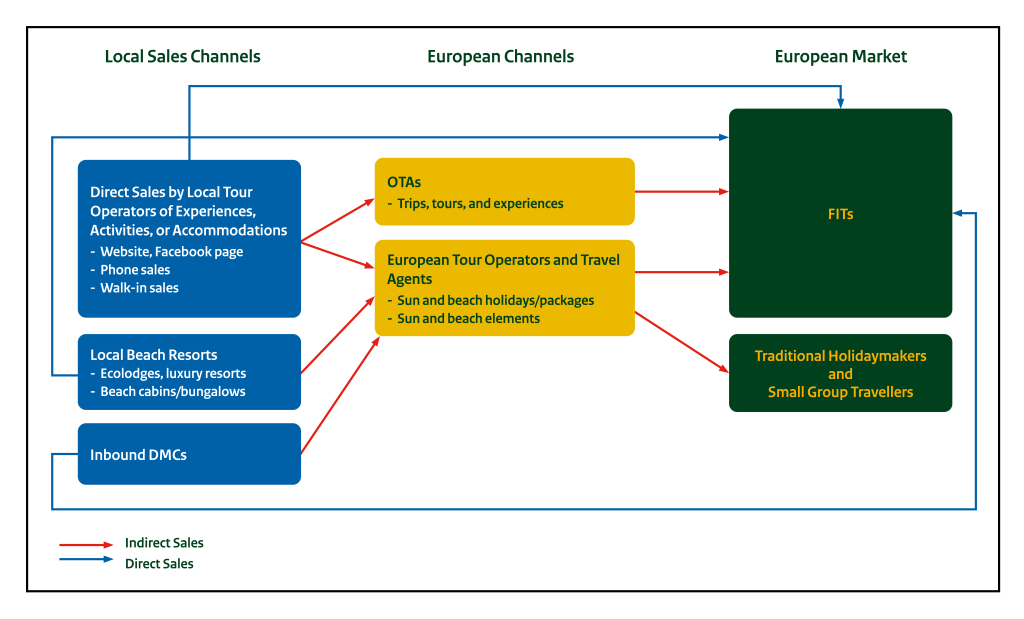
Source: Acorn Tourism Consulting, 2024
The process is further explained below.
Local Sales Channels are a mix of direct sales, local beach resorts and DMCs.
- Direct sales are made directly to FITs by tour operators or accommodation providers. Sales can be made on your website, by phone or through direct walk-ins. They will find you through internet searches, social media platforms that direct them to your website and word of mouth.
- FITs also buy directly from sun and beach resort providers, ranging from luxury and ecolodges to smaller beach cabins and bungalow providers.
- DMCs are usually B2B organisations (business to business) and sell to European tour operators. However, depending on their business model, some DMCs sell local tour operator products to FITs directly.
European Channels are a mix of OTAs (online travel agencies), European tour operators and travel agencies.
- OTAs sell a range of accommodation types, trips and experiences to FITs directly. Major OTAs like Booking.com, Airbnb and Hotels.com are commonly used to find accommodation in beach locations. On the Beach is a specialist OTA that sells package holidays and has European branches in the UK, Sweden, Norway and Denmark. OTAs that sell sun and beach trips and experiences, often boat trips, include Viator, GetYourGuide and Musement.
- European tour operators sell a range of beach-based holidays and experiences to traditional holidaymakers and small-group travellers. They are often luxury providers. Examples include Abercrombie & Kent and Kuoni (UK), Traum Reisen and Away from it All (Germany), Voyageurs du Monde and My Luxury Travel (France), and Silk Travel and Bay Travel (Netherlands). They may include experiences in their packages that they source from local tour operators or DMCs.
- European travel agencies typically sell package holidays, often all-inclusive, and sun and beach holidays are their biggest market. Examples include TUI and DER Touristik (Germany), Jet2 Holidays and Hays Travel (UK), Club Med and Voyages Pirates (France), and Sunweb (Netherlands).
What is the most interesting channel for you?
Your key sales channels are direct sales made through your website and sales made through OTAs. Building your website should be your main priority. For detailed information on improving or creating your website, read the CBI study How to be a successful tourism company online.
You should also work with the OTAs. To find out more about working with OTAs, consult this Arival Guide, Working with OTAs, and the CBI’s Tips for organising your tourism services export to Europe.
To work with specialist tour operators, see the CBI’s Doing Business with European tourism buyers for tips on working with European tour operators.
Tips:
- Learn more about the different sales channels. As sun and beach products for FITs can be related to adventure tourism, read the CBI’s Entering the European market for adventure tourism, specifically the section ‘Through what channels do adventure tourism travel products end up on the end-market?’.
- Conduct market research to learn more about the travel trade in target countries. The Visit Britain Inbound Markets website is a good place to start. Each country has a market profile with useful information on the national travel trade. See Germany’s as an example.
3. What competition will you face in the sun and beach market?
Developing countries offer some of the best sun and beach destinations. Many beach resorts offer both water and land-based activities for their guests. Eco-beach resorts are becoming more common as the demand for sustainability in tourism increases and the need to address climate change becomes more important.
Which countries are you competing with?
Sun and beach destinations are found all over the world, but developing countries are home to some of the best. FITs particularly look for destinations away from mass-market ones. However, it is a very competitive sector and there are many destinations and a wide range of less-developed beaches. For many FITs, destinations that are harder to reach are more appealing, and those that offer additional experiences, such as CBT, are also likely to be attractive.
Indonesia, Kenya, Mexico and Thailand are major destinations and are profiled below. However, you should also consider Brazil, Colombia, Costa Rica, Madagascar, Malaysia, Mozambique, Nicaragua, South Africa, Tanzania, Vietnam, the Indian Ocean Islands (the Maldives, Mauritius and the Seychelles) and the islands of the South Pacific, including Fiji and French Polynesia.
Indonesia
Indonesia is famous for its stunning white sandy beaches, crystal waters and more than 17,000 tropical islands. Indonesia has many beaches, each offering a wide range of beach-related activities. Indonesia also has a strong cultural offer that complements the sun and beach. The Pink Beach on Komodo Island is famous for its salmon-coloured sands, while Trikora Beach on Bintan Island is a collection of several beaches, each with its character.
Bali is home to several notable beaches and is very popular among FITs. The three Gili Islands in Lombok are peaceful beach destinations where cars and motorbikes are prohibited.
Indonesia is working to fully recover its tourism industry by developing five super-priority tourism destinations (DPSP) in Lake Toba, Borobudur, Mandalika, Labuan Bajo and Likupang. This includes improving infrastructure and conforming with sustainability-related principles.
Implementing sustainable tourism is another key step. To support this, in 2023, the Ministry of Tourism and Creative Economy implemented a campaign focused on environmental sustainability called ‘Every Step Matters’ to encourage tourists to care for Indonesia’s environment. It aims to reduce carbon emissions by up to 50% by 2030 and to achieve net zero by 2045.
Kenya
Kenya is best known for its wildlife, but the country’s unspoiled beaches on the Indian Ocean coast are often combined with a safari. Sun and beach activities are centred around the coastal towns of Mombasa and Malindi, where water sports, diving, marine and wildlife watching and deep-sea fishing are popular among groups and families.
Beach destinations in the north and south are more remote, and many luxury resorts appeal to honeymooners. The island of Lamu has a distinct, easy-going culture that offers a distinct sun and beach experience.
Kenya has a good reputation for sustainable tourism. Many places have banned single-use plastics. Coastal resorts regularly organise weekly beach clean-ups and have adopted eco-friendly water treatment facilities. The Ecotourism Kenya scheme operates a series of programmes to promote ecotourism in the country and help businesses become sustainable. The Ecotourism Kenya Eco-rating Certification Scheme supports the activities.
Figure 4: Tropical beaches with sparkling waters are popular among European sunseekers
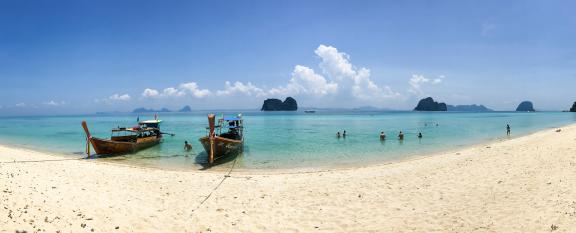
Source: Wojciech Portnicki at Unsplash, 2018
Mexico
Mexico is a leading tourist destination, and its beaches play a large part in its appeal. There are numerous beaches on Mexico’s coastline, both on the Gulf of Mexico and Pacific coasts, with plenty of variety. Jungles and ancient ruins surround some; some are good for surfing and others for swimming and snorkelling. Besides the well-known tourist destinations, there are also lesser-known beach destinations that offer opportunities for local operators.
Mexico’s best-known beach destinations include Cabo San Lucas, a luxury destination on the tip of Baja California, Tulum, close to Mayan ruins, Cancun and Puerto Vallarta. However, lesser-known beach destinations are known to be more eco-friendly and provide more authentic Mexican experiences. These include Todos Santos, nine little bays of Huatulco and Puerto Escondido on the Oaxaca coast.
Safety may be a concern for travellers to Mexico as a result of terrorist activity, usually associated with drug cartels. European tourists will likely check with official sources before they travel so they are fully aware of the situation. The UK’s Foreign, Commonwealth and Development Office (FCDO) provides comprehensive advice to travellers. It currently advises against all but essential travel to some parts of Mexico, and lists all areas to be avoided, including Acapulco. It is important that you are aware of any risks of travelling to your country and region.
Thailand
Thailand is another leading destination for sun and beach tourism. It has attracted sunseekers for many decades. Both backpackers and luxury tourists travel to Thailand to visit its glorious tropical beaches. The best beaches are found predominantly in the south, including on the islands of Koh Samui, Koh Phang Nga and Phuket. All offer many facilities and activities. Further south, the beaches in the Trang Archipelago, such as Koh Kradan and Koh Ngai, are more remote and have fewer facilities.
The Thai government has taken steps to improve sustainability throughout the country. Some initiatives it introduced include closing heavily-visited regions to allow for regeneration, including Maya Beach in Koh Phi Phi in 2018. This beach was made famous as a location in the movie The Beach, which meant it attracted lots of additional visitors. The beach reopened again in 2024 but has regular periods during the year when it is closed to visitors.
Several businesses incorporate sustainability practices in their activities. Trash Hero is a community-based organisation that works to remove waste and change habits to reduce future waste. The organisation has removed more than 2.5 million kg of litter in 13 countries. The Tourism Authority of Thailand has also created a special website focusing on seven green projects, which tells tourists how to travel responsibly and about initiatives they can take part in.
Figure 5: Trash Hero community beach clean-up in Thailand
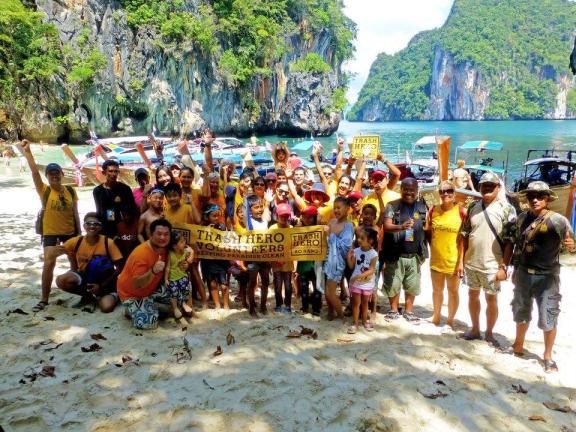
Source: Trash Hero, 2024
Key Takeaways:
- Check what sustainability schemes operate in your destinations. The government may provide grants to help businesses become sustainable.
- Research the sun and beach destinations in your country. Analyse where the hotspots are and where the less-visited beaches are. Identify the most popular activities. Is there a gap in the market that you could develop into a sustainable sun and beach product?
- Many sun and beach destinations appeal to honeymooners and the luxury market. Download the CBI studies What are the opportunities for honeymoon tourism from Europe and What are the opportunities for luxury tourism from Europe.
Which companies are you competing with?
Operators in the less-developed sun and beach segment include a broad mix of resorts, accommodation types (hotels, guest houses, beach bungalows, homestays) and clubs on or near the beach. Those with CBT opportunities and additional activities for their guests are more likely to appeal to FITs who like immersive travel experiences.
Companies in Indonesia
LooLa Adventure Resort is an award-winning eco-resort on the island of Bintan. It combines adventure and community adventures with a beachside location. Its website features images and strong straplines like ‘Have fun and help the planet’, ‘Gorgeous eco accommodation’ and ‘Recharge and reconnect with nature’. These give potential visitors clear reasons to choose to stay with them.
Numerous activities are available, including kayaking, raft building, rock climbing, ziplining and trekking. The operator’s eco-activities are outlined in great detail on their website. Guests are encouraged to take part in eco-activities, such as clearing up the beaches, planting mangroves and plant-based cooking activities. Families are a key market, and accommodation has been built in the local style above the sea and along the beachfront.
Dream Beach Huts in Nusa Lembongan, Bali, is a collection of 28 thatched-roofed bungalows inspired by traditional rice barns. Each bungalow has a private terrace that overlooks the sea or tropical foliage. Activities at the resort include diving with manta rays, surfing, snorkelling, exploring the mangroves and boat trips. It would be advisable for this business to add its sustainability actions to its website.
The website is attractive and uses images well to appeal to potential guests.
Companies in Kenya
Turtle Bay Beach Club is an award-winning, responsible resort located south of Malindi. It is also an eco-hotel that offers a wide range of activities in addition to sun and beach, such as bird watching, deep sea fishing, dhow sailing, snorkelling and diving. It also directly supports the community through local community initiatives. The resort is aimed at the family market. It links to its eco-policy, which fully outlines its activities in water, purchasing, energy, waste, sewage, community and gardens.
Kizingo is a collection of eight beach-front bandhas (thatched houses) built by local islanders from local materials, including mangrove, muti and mkeka. The resort is located on a remote stretch of coast on Lamu Island, and it is car free. The beach has been left to nature rather than developed. This adds to its attraction for guests. Activities include swimming with dolphins, dhow sailing and water skiing. Trips to Lamu Town are taken by boat.
The operator is committed to conservation, supports the local village and school and uses solar panels to provide electricity. The website features details of their sustainability actions.
Companies in Mexico
Villa Pescadores in Tulum on the Riviera Maya features rustic cabanas on the beach, close to Mayan ruins and local fishermen’s boats. The cabins were constructed using local stone and wood, and they are built on white sand with private gardens and hammocks. The hotel provides yoga classes. The hotel is part of the Ahau Collection of properties. You can view the hotel chain's sustainability actions regarding sustainable development and community improvement goals.
The home page is strong and inviting, with scrolling images and special offers. It uses icons to highlight what customers can expect to enjoy. The website is available in Spanish and English.
Figure 6: Villa Pescadores

Source: Villa Pescadores, 2024
Xinalani Retreat in Puerto Vallarta offers beachfront bungalows on stilts, built by local Mexican craftsmen. The accommodation was designed to take advantage of natural elements, beautiful views and fresh sea breezes from the Pacific Ocean. There is a restaurant, bar and beach club on site, and it boasts activities like wellness and yoga. An inspirational video on the homepage showcases the accommodation, views and activities.
It features a ‘10 things you should know’ that details information for visitors about living ‘off-grid’. The page covers topics like access to the eco-retreat, the number of stairs, food and the features of staying in nature.
Companies in Thailand
FaaSai Resort & Spa, ‘Where the forest meets the sea,’ is an eco-resort committed to preserving the environment and supporting the local community. CBT activities are encouraged, and the resort has won numerous awards. There are only 14 rooms, and the emphasis is on enjoying a peaceful atmosphere close to a small beach and fishing village surrounded by tropical gardens.
The website is slightly old-fashioned by today’s standards and could use a refresh. The images are small and not inspirational, and the framework is old-fashioned. However, it is mobile-friendly, which is very important nowadays.
Castaway Beach Resort in Koh Lipe was designed using eco-friendly traditional Thai building principles. Bungalows are either beachfront or offer views of the sea or gardens. It is clearly stated what is included in the bungalows (mosquito nets, hammocks, beach mats, etc.) and what is not (air conditioning, hot showers, TVs, etc.). This is excellent practice as it means customers are fully informed.
All their sustainability actions are fully detailed, and they have a good mix of images and hand-drawn diagrams. The resort also supports Trash Heroes, their waste-clearing initiatives, and an animal welfare charity.
Key Takeaways:
- You must act sustainably in your business. Be inspired by other businesses’ sustainability actions to help you establish your own. If you can involve your guests in things like beach clean-ups or wildlife monitoring, you can advertise this on your website, and it will impress your buyers.
- Keep your website up-to-date and fresh. Travel websites must be attractive and well-designed to stand out. If your website looks old, consider building a new one. Online website builders are cost-effective ways of doing this. There are plenty of CBI studies to help you with your website. How to be a successful tourism business online is a good place to start.
- For an example of a sun and beach operator situated on the shores of a lake, take a look at the Usisya Beach Eco-Lodge in Lake Malawi and take note of all the CBT activities it offers its guests.
Which products are you competing with?
Trips and experiences on the broader adventure tourism market are your biggest competitors, particularly ones that combine sun and beach on the same trip. You should also carefully consider CBT experiences as a competing product. They are often included in sun and beach tourism travel products in areas not commonly regarded as mass-market sun and beach tourism locations.
Tips:
- Conduct an analysis to identify your business’s strengths, weaknesses, opportunities and threats (SWOT analysis). Be honest about what you do well and what you could improve so you can make measurable improvements to your business. Read this guide to help you do a SWOT analysis.
- Research what other operators and providers in your area do. This will ensure that you understand the market in your area thoroughly and you can identify what works well and what you could do to compete more effectively.
4. What are the prices for sun and beach products on the European market?
Prices for sun and beach holidays vary hugely across the world, and there is no set formula. Prices depend on popularity, seasonality, what is included in the price and what is not, activities offered and so on. Generally, resorts with sustainable credentials charge more, as they are often chosen by visitors prepared to pay more to contribute positively to the local community or offset any guilt they might feel about travelling.
The table below shows prices within the three budget groups and the main competing destinations.
Table 2: Example prices of overnight stays in beach resorts in competing destinations
| Resort/Property Name | Country | Price guide for two people, 3 nights, in November 2024 (€) |
| Babus Bay Homestay, Lake Toba | Indonesia | 61 |
| FaaSai Resort and Spa | Thailand | 67 |
| Castaway Beach Resort, Koh Lipe | Thailand | 193 |
| Dream Beach Huts, Nusa Lembongan | Indonesia | 222 |
| Pwani House, Lamu Seafront | Kenya | 228 |
| Vila Ombak, Gili Islands | Indonesia | 233 |
| Hotel Villa Malindi | Kenya | 290 |
| The Reef Resort, Koh Kradan | Thailand | 374 |
| Tembo Beach Club and Resort, Koh Samui | Thailand | 388 |
| Villa Pescadores, Tulum | Mexico | 394 |
| Turtle Bay Beach Club, Watamu | Kenya | 432 |
| Serendipity, Todos Santos | Mexico | 489 |
| LooLa Adventure Resort, Bintan | Indonesia | 493 |
| Villas Carrizalillo, Puerto Escondido | Mexico | 715 |
| Kizingo Beach Eco Lodge, Lamu | Kenya | 967 |
| Xinalani Retreat, Puerto Vallarta | Mexico | 1,583 |
Source: Booking.com, 2024
Tips:
- Research competitors to find out what local resorts, hotels, guesthouses and homestays charge per night in your destinations.
- Assess what is included in the price per night, such as breakfast or a free transfer to the airport or railway station. You must do this so you are fully aware of the costs associated with the price so you can set your prices accordingly.
- Consider the seasonality of your destination so you can set competitive prices to encourage visitors outside of peak season.
Acorn Tourism Consulting Limited carried out this study on behalf of CBI.
Please review our market information disclaimer.
Search
Enter search terms to find market research
